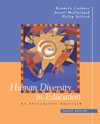This book strives to better prepare today's teachers to achieve their goals of delivering an effective education to diverse students who are living in a complex, interdependent world. The approach used in this book begins by recognizing the kinds of experiences many, but not all, individuals who become teachers bring with them. It is with the classroom teachers in concert with their peers and community that effective education can occur. For the most part, today's teacher education students are from the majority culture and have limited experience with people of different backgrounds. For that reason this book attends to such issues as people's emotional responses and other kinds of experiences people have when they encounter difference or diversity. Understanding the socialization process in terms of cultural development and the obstacles to culture learning helps educators gain insight into the reasons for typical responses and facilitates the processes necessary to transcend, or move beyond, one's conditioning. Understanding how many of the various processes, such as communication and learning style, impact on interaction and learning is also critical to effective teaching. This book looks at how society and education have responded to cultural diversity in a variety of contexts. Each of the various diversities addressed in this book mediate one another and do not act in isolation, which further complicates an educator's task but is nonetheless critical to an understanding of classroom interaction. Only recently has our nation been addressing issues related to diversity in any real sense. In a few short decades, development in related fields has tended to move from that of totally ignoring diversity in the hopes of complete assimilation to that of encouraging and recognizing the value of pluralism in a diverse democratic society. Schools—as well as individuals who have been successful at addressing such issues—have been working on these issues for a long time. Innovations in individual perspective and behavior as well as in curriculum and instructional modification do not come quickly and cannot show immediate results. Such efforts require a long-term commitment on the part of many actors—teachers, administrators, students, parents, community, and material developers—before any of the hoped for changes can be realized. Removing the various barriers and modifying conditioned behavior takes time. We must be willing to act and work accordingly over the long haul; that is, we must take whatever time is needed to realize such changes and not be discouraged in the short run. Successes must be measured in inches rather than miles and must be perceived by all actors as being developmental, or evolutionary, in nature, not revolutionary. As such, efforts must begin in the early stages of education, both for children and adults, and must continue throughout. Such efforts are not ones that can be effectively addressed in one short course or class or for a short period of time. Continuous efforts must be made at many different levels in the educational process. It is hoped that, for you, this book is just one step on a personal and professional path of continual growth, development, and interaction. |



 2003 McGraw-Hill Higher Education
2003 McGraw-Hill Higher Education